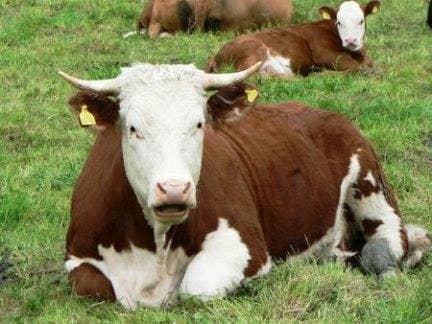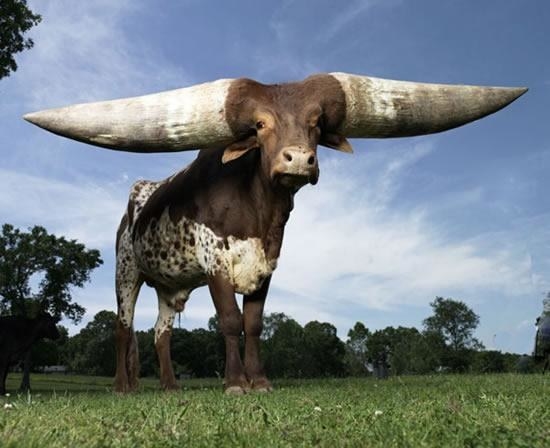Why do we Dehorn cattle?

What are the ways to dehorn cattle?
There are a couple of ways the industry dehorns cattle. The first way is to do gouge dehorning. This is done using an embryotomy wire, guillotine shears, or dehorning knives, saws, spoons, cups, tubes, or rubber bands. The most common way is the Barnes-type scoop dehorner (AVMA et. al. 2014). The other ways involve a chemical and hot-iron method, which is more for disbudding. This method destroys all of the horn-producing cells (AVMA et al., 2014). This method requires a local anesthesia after they reach a certain age.
How much pain really is there?
Pain is defined as some unpleasant sensory and emotional experience associated with tissue damage (Neave et al., 2013). In an experiment done at the University of British Columbia, they tested how pain from dehorning affects cognitive processes in cattle. They did two experiments and trained them to respond differentially to red and white video screens after hot-iron disbudding. After disbudding calves were more likely judging the ambiguous colours as negative. This indicates that after hot-iron disbudding it will result in a negative change in emotional state (Neave et al., 2013). This is the main reason why it is important to supply the calves with an anesthetic to numb the pain and make sure we take care of them to the best of our ability.
What is the best method for injecting local anesthetics and what's the most common sedative used?
Ann-Helena Hokkanen, a faculty of veterinary medicine member at the University of Helsinki in Finland, is a big believer in injecting the calf with pain medication before disbudding. If you inject 80 μg/kg of detomidine sublingually, it had an equally potent sedative effect as 30 μg/kg intravenously detomidine that was administered (Hokkanen et al., 2015). This means it is better to administer the detomidine intravenously because there is a less amount required to be given. The most common sedative used is xylazine before hot-iron disbudding, but detomidine has been studied the most in calves (Hokkanen et al., 2015).
Can we really breed no-horn cows?
There are only a select few cows that have a dominant no-horn genetic trait, called polled cows (Pitt et al., 2015). While it is obvious the industry focuses mainly on boosting milk productivity, it still tries to make changes that better the animal welfare situation. While only less than 1% of the nation's dairy herds contain the hornless polled gene, there has been a 10 times more polled animals registered with breeding programs over the last 3 years (Pitt et al., 2015). This shows that the industry is working hard to help. This is a huge labor saving problem if we could someday breed no-horn cows. However, since the gene pool is so limited, it may take a long time before we actually see this coming into effect, so I would suggest you keep learning about proper dehorning/disbudding techniques.
How big can horns get?

What is happening?????
Literature Cited
Anderson, N. 2009. Dehorning of Calves. Queen's Printer for Ontario P. 1-12.
By Spooky on May 22nd, 2008 Category: Animals, Pics. "Lurch, the Bull with the Largest Horns in the World | Oddity Central - Collecting Oddities." Oddity Central Collecting Oddities. N.p., 03 Oct. 2008. Web. 01 Nov. 2016.
"Disbudding Calves." NADIS. NADIS, n.d. Web. 01 Nov. 2016.
Hokkanen, A. 2015. Hot-iron disbudding pain in calves. Dissertationes Scholae Doctoralis Ad Sanitatem Investigandam Universitatis Helsinkiensis P. 1-59.
Literature Review On The Welfare Implications Of The. Dehorning and Disbudding of Cattle (n.d.): n. pag. American Veterinary Medical Association, 15 July 2014. Web. 1 Nov. 2016.
"Natural World of Living Things." Natural World of Living Things. N.p., 25 Nov. 2012. Web. 01 Nov. 2016.
Neave, H., Rolnei R. Daros, João H. C. Costa, Marina A. G. von Keyserlingk, Daniel M. Weary. 2013. Pain and Pessimism: Dairy Calves Exhibit Negative Judgement Bias following Hot-Iron Disbudding. PLOS ONE P. 1-5.
Pitt, David. "Dairy Farms Asked to Consider Breeding No-horn Cows." Dairy Farms Asked to Consider Breeding No-horn Cows. The Associated Press, 28 Mar. 2015. Web. 01 Nov. 2016.

